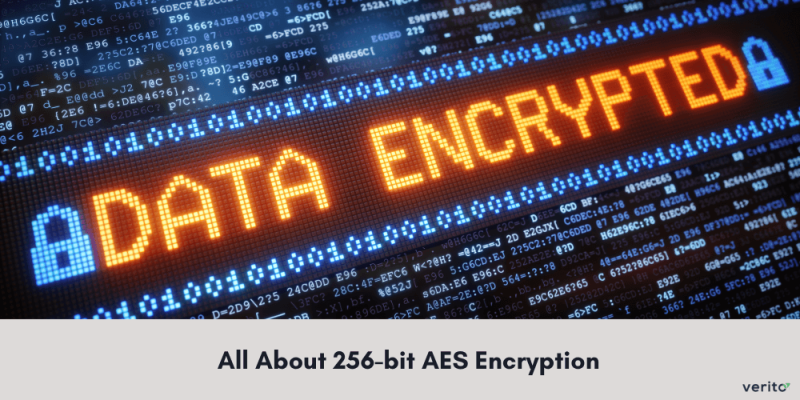According to a recent study conducted by the Ponemon Institute, businesses can save around $1.4 million per attack with tight encryption strategies in place. This statistic further emphasizes the crucial role encryption plays in maintaining the integrity and confidentiality of organizations.
In an era where our lives are increasingly intertwined with the digital realm, robust cybersecurity measures cannot be overemphasized. Businesses store enormous amounts of personal and sensitive information on their devices/assets, ranging from financial records to clients’ data.
Data encryption has emerged as an essential tool in the arsenal of IT security to protect this wealth of data from falling into the wrong hands. In this blog post, we’ll dive into the significance of data encryption and shed light on what 256-bit AES encryption means.
What is 256-bit AES Encryption?
256-bit AES encryption is a highly secure encryption algorithm widely used to protect sensitive data. AES stands for ‘Advanced Encryption Standard,’ which has become the de facto standard for encrypting data in various applications and industries.
The term ‘256-bit’ in its name refers to the length of the encryption key used in the algorithm. The encryption key is a sequence of 256 bits (0s and 1s) used to scramble and protect the original data. The longer the key, the more possible combinations there are, and the more secure the encryption becomes.
To encrypt data using 256-bit AES encryption, the algorithm applies complex mathematical operations to the original data and the encryption key. This process transforms the data into a cipher, which appears as a seemingly random and unreadable sequence of characters.
Decryption, however, involves reversing the process using the encryption key to get the cipher back into its original form. Without the correct key, attempting to decrypt the data would be extremely difficult, if not impossible.
256-bit AES encryption is considered highly secure because the number of possible combinations with a 256-bit key is huge. It would take impractical time and computational power to try all possible combinations to decrypt the data without the correct key. This level of security makes it suitable for protecting sensitive information, including financial records, personal data, and confidential communications.
Also Read: A Complete Guide to IT Outsourcing
How Does 256-bit AES Encryption Work?
Let’s dive into how 256-bit AES encryption works at a deeper level:
-
Key expansion
This is the first step in the encryption process. Here, the original encryption key, which is 256 bits long, undergoes a series of transformations to generate a set of round keys used in the subsequent encryption rounds.
-
Initial round
In the initial round, the input data is divided into fixed-size blocks, typically 128 bits each. The first round key is combined with the input data using a bitwise XOR process.
-
Rounds
Here, the encryption process consists of multiple rounds (usually 14 rounds for 256-bit AES), each of which involves several transformation stages:
a. SubBytes: In this stage, each byte of the data block is replaced with a corresponding byte from a substitution table.
b. ShiftRows: The bytes in each row of the data block are shifted cyclically. This operation provides diffusion, ensuring that even small changes in the input affect multiple output bytes.
c. MixColumns: In this stage, each column of the data block is mixed using a mathematical operation called matrix multiplication. This step provides additional diffusion and ensures that every bit of the output depends on every bit of the input.
d. AddRoundKey: The data block is combined with a round key in each round using bitwise XOR. The round key is derived from the original encryption key during the key expansion phase.
-
Final round
The final round is similar to the previous one but excludes the MixColumns stage. It ensures that the encryption process is reversible and allows decryption later.
-
Cipher text
After the final round, the encrypted data, known as the cipher text, is obtained and is a scrambled version of the original data. It appears as a seemingly random sequence of characters.
To decrypt the data, the encryption process is reversed. The cipher text goes through the decryption process, which involves using the same encryption key and performing the inverse operations in reverse order. This process retrieves the original plain text.
Recommended Read:
Top Cybersecurity Threats You Should Know About
Role of a Managed IT Service Provider for 256-bit Data Encryption
If you are thinking about how you will benefit from 256-bit AES encryption, worry not! A reliable managed IT service provider (MSP) can be crucial in implementing and maintaining data encryption as part of your organization’s IT security strategy.
Here are some ways in which an MSP can help:
-
Expertise and guidance
An MSP specializes in IT security and encryption practices. The experts can assess your organization’s needs, evaluate potential vulnerabilities, and recommend appropriate encryption solutions. Their expertise ensures that the encryption implementation aligns with industry best practices and compliance requirements.
-
Encryption implementation
Implementing data encryption can be complex, especially when dealing with various systems, networks, and devices. An MSP can handle the implementation process to ensure that encryption protocols and algorithms are correctly integrated into your organization’s infrastructure. They can configure encryption settings, deploy encryption software or hardware, and ensure proper encryption key management.
-
Encryption key management
Encryption keys are a vital component of data encryption. MSPs can assist in establishing robust key management practices. This includes generating and securely storing encryption keys, implementing key rotation policies, and defining access controls to ensure authorized personnel can access encrypted data when needed.
-
Ongoing monitoring and maintenance
256-bit AES encryption is not a one-time implementation but requires continuous monitoring and maintenance. An MSP can proactively monitor encryption systems, ensure they operate correctly, and identify potential issues or vulnerabilities. They can perform regular security assessments, update encryption software and protocols, and promptly address emerging threats or weaknesses.
Recommended Read: 5 Cybersecurity Metrics You Should Never Ignore
Join Hands with Verito Technologies for Managed IT Services
Partnering with Verito Technologies as a managed IT service provider empowers your organization to leverage our expertise, specialized tools, and proactive approach to data encryption. By entrusting your encryption needs to us, you can enhance your security posture, comply with regulations, and gain peace of mind.
To discuss your business requirements, contact us here.







